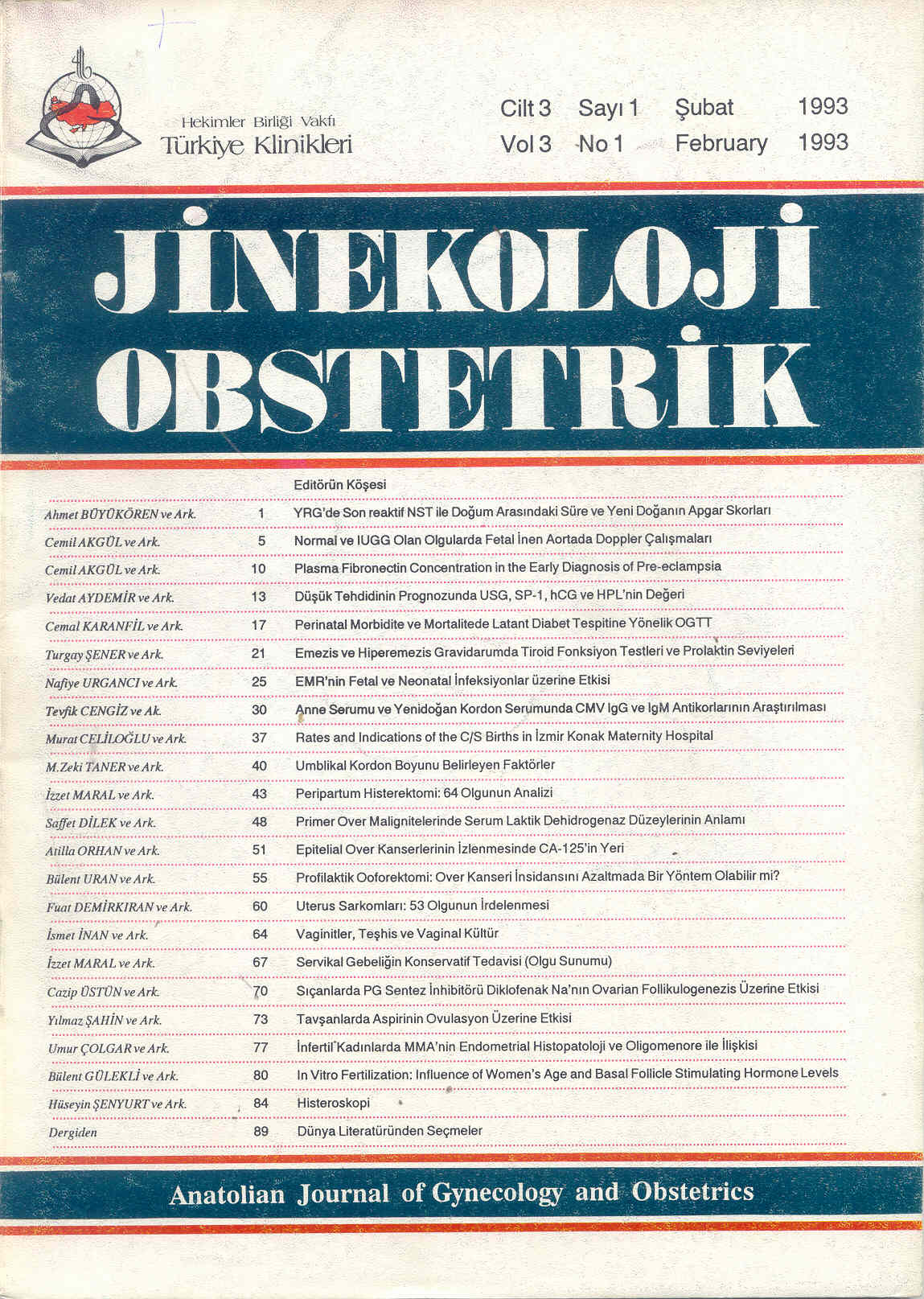Open Access
Peer Reviewed
ARTICLES
4011 Viewed1356 Downloaded
Peripartum Hysterectomy: Analysis Of 64 Cases
Peripartum Histerektomi: 64 Olgunun Analizi
Turkiye Klinikleri J Gynecol Obst. 1993;3(1):43-7
Article Language: TR
Copyright Ⓒ 2025 by Türkiye Klinikleri. This is an open access article under the CC BY-NC-ND license (http://creativecommons.org/licenses/by-nc-nd/4.0/)
ÖZET
Peripartum histerektomi tanımı içine elektif sezaryen histerektomiler, acil sezaryen histerektomiler ve postpartum histerektomiler girer. Obstetrik kanamanın durdurulamadığı olgularda acil histerektomi hayat kurtarıcı bir operasyondur. Bu çalışmada; 1980-1991 yılları arasında SSK Tepecik Doğumevi ve Kadın Hastalıkları Hastanesinde peripartum histerektomi yapılan 64 olgu retrospektif olarak incelenmiştir. Peripartum histerektomi sezaryenlerde 24 (%0.26), vaginal doğumlarda 40 (%0.033) hastada uygulanmıştır. En önemli endikasyonlar uterus rüptürü (%56.2) ve atoni (%18.7) olarak tespit edilmiştir. Onbeş olguya total abdominal histerektomi (TAH), 49 olguya subtotal histerektomi (STH) uygulanmıştır. İntraoperatif total kan transfüzyon miktarları yönünden iki operasyon arasındaki farklılık istatistiki olarak anlamlı bulunmuştur (p>0.05). Konu ile ilgili literatür gözden geçirilerek tedavi metodları, operatif ve postoperatif komplikasyonlar ve morbidite tartışılmıştır.
Peripartum histerektomi tanımı içine elektif sezaryen histerektomiler, acil sezaryen histerektomiler ve postpartum histerektomiler girer. Obstetrik kanamanın durdurulamadığı olgularda acil histerektomi hayat kurtarıcı bir operasyondur. Bu çalışmada; 1980-1991 yılları arasında SSK Tepecik Doğumevi ve Kadın Hastalıkları Hastanesinde peripartum histerektomi yapılan 64 olgu retrospektif olarak incelenmiştir. Peripartum histerektomi sezaryenlerde 24 (%0.26), vaginal doğumlarda 40 (%0.033) hastada uygulanmıştır. En önemli endikasyonlar uterus rüptürü (%56.2) ve atoni (%18.7) olarak tespit edilmiştir. Onbeş olguya total abdominal histerektomi (TAH), 49 olguya subtotal histerektomi (STH) uygulanmıştır. İntraoperatif total kan transfüzyon miktarları yönünden iki operasyon arasındaki farklılık istatistiki olarak anlamlı bulunmuştur (p>0.05). Konu ile ilgili literatür gözden geçirilerek tedavi metodları, operatif ve postoperatif komplikasyonlar ve morbidite tartışılmıştır.
ANAHTAR KELİMELER: Peripartum histerektomi, obstetrik hemoraji
ABSTRACT
Peripartum hysterectomy includes elective cesarean hysterectomy, emergency cesarean hysterectomy and postpartum hysterectomy. In cases of intractable obstetric bleeding, emergency hysterectomy is a life-saving procedure. In this study, a retrospective review of 64 cases who were underwent peripartum hysterectomy at SSK Tepecik Maternity Hospital for 12 years period 1980 through 1991 was conducted. Peripartum hysterectomy was performed in 24 (0.26%) patients delivered by cesarean section, and was performed in 40 (0.033%) patients delivered by vaginal route. The most common indication for hysterectomies was uterine rupture (56.2%), followed by atony (18.7%). Fifteen cases were treated by total abdominal hysterectomy (TAH). Forty-nine cases were treated by subtotal hysterectomy (STH). We found statistically significant differences between TAH and groups in intraoperative total blood transfusion (p< 0.05). Statistically significant differences were not noted between these groups in number of transfused patients, operative time and postoperative hospital stay (p> 0.05). Literature on the subject is reviewed. Treatment methods, operative and postoperative complications are discussed.
Peripartum hysterectomy includes elective cesarean hysterectomy, emergency cesarean hysterectomy and postpartum hysterectomy. In cases of intractable obstetric bleeding, emergency hysterectomy is a life-saving procedure. In this study, a retrospective review of 64 cases who were underwent peripartum hysterectomy at SSK Tepecik Maternity Hospital for 12 years period 1980 through 1991 was conducted. Peripartum hysterectomy was performed in 24 (0.26%) patients delivered by cesarean section, and was performed in 40 (0.033%) patients delivered by vaginal route. The most common indication for hysterectomies was uterine rupture (56.2%), followed by atony (18.7%). Fifteen cases were treated by total abdominal hysterectomy (TAH). Forty-nine cases were treated by subtotal hysterectomy (STH). We found statistically significant differences between TAH and groups in intraoperative total blood transfusion (p< 0.05). Statistically significant differences were not noted between these groups in number of transfused patients, operative time and postoperative hospital stay (p> 0.05). Literature on the subject is reviewed. Treatment methods, operative and postoperative complications are discussed.
MENU
POPULAR ARTICLES
MOST DOWNLOADED ARTICLES





This journal is licensed under a Creative Commons Attribution-NonCommercial-NoDerivatives 4.0 International License.










